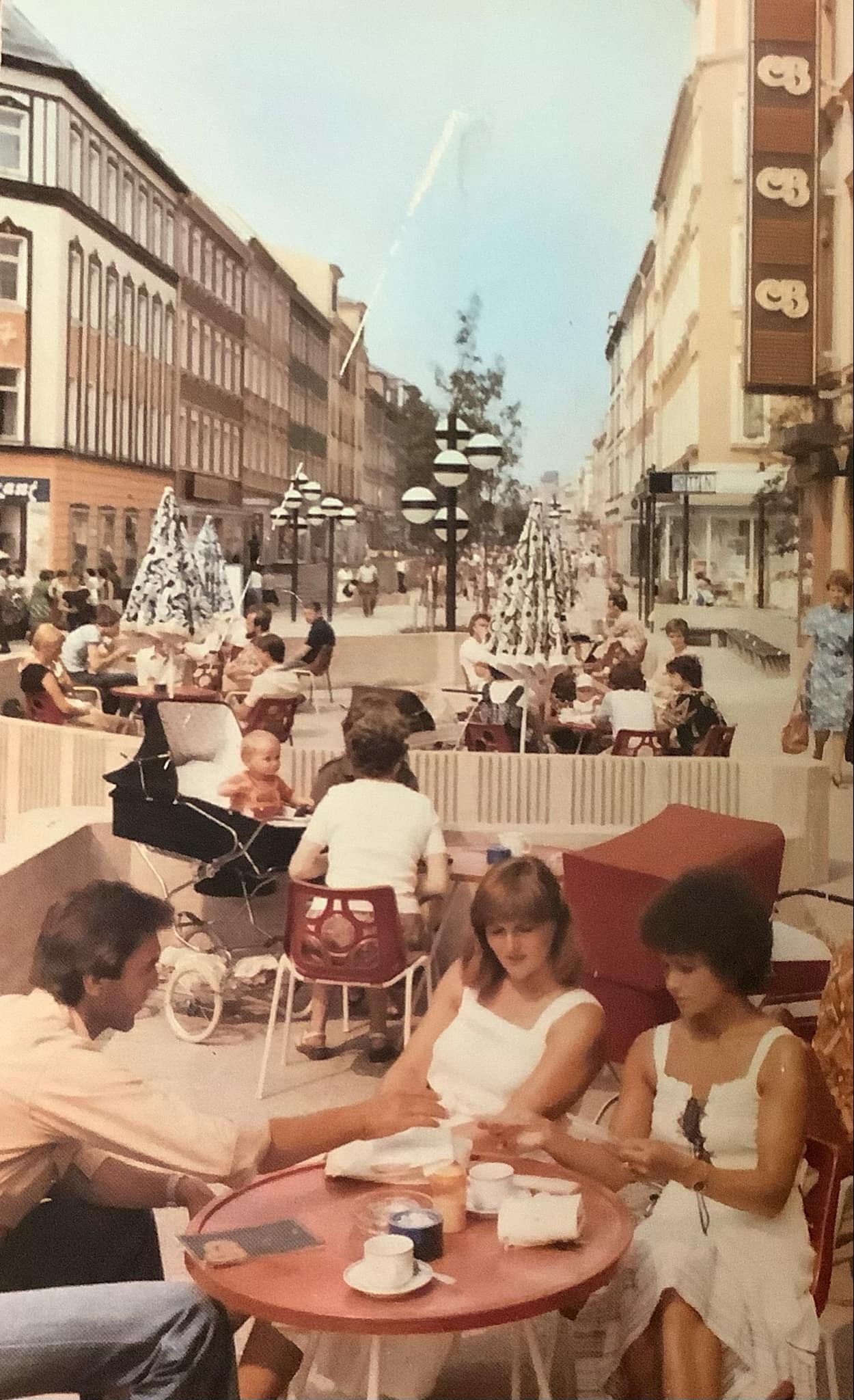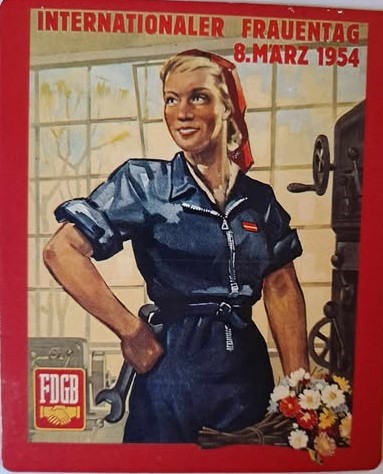The German Democratic Republic - a different world
by Pat Turnbull
‘The development of the productive forces and socialist relations of production have enabled our people to attain a standard of living without precedent in their history. Unemployment is a concept from a different, alien world. Material comfort, a sense of security, full employment and equal educational opportunities for all children are a matter of course. For us, the highest priority is to preserve peace and, hence, assure our future existence.’
These words from Erich Honecker, General Secretary of the SED (Socialist Unity Party) Central Committee and Chairman of the German Democratic Republic Council of State, open the little book The German Democratic Republic (Panorama DDR, Berlin 1986).
They’re words from a different world, a world that came to an end 35 years ago on 3rd October 1990, when the GDR ceased to exist. This year, 2025, is also the 80th anniversary of the end of the Second World War on 8th May 1945, when the country that was to become the GDR started on its road.
These anniversaries are an occasion to remember what the GDR really was, in contrast to the crude propaganda picture spread by the ruling classes in the west.
FOUNDATIONS
The foundations of the GDR were established in the Soviet Zone of a Germany divided between the four occupation powers - the Soviet Union, the USA, Britain and France. The occupation zones of the three western allies had together a population of about 43 million; the Soviet Zone had about 17 million.
In the Soviet Zone, as early as June 1945, the Soviet Military Administration in Germany authorised the formation of antifascist and democratic parties and mass organisations. The German population could see posters with Stalin’s famous declaration, ‘Hitlers come and go, but the German people and the German state remain’ – a statement he made on February 23rd 1942, when the Soviet Union was embroiled in a bitter war with Hitler’s forces.
On 14th July 1945 the Communist Party of Germany, the Social Democratic Party of Germany, the Christian Democratic Union of Germany and the Liberal Democratic Party of Germany formed a bloc of antifascist and democratic parties, from 1949 onwards known as the Democratic Bloc. The first mass organisations were the Confederation of Free German Trade Unions, the League of Culture, and youth and women’s committees.
That summer too new administrative bodies were formed, made up of antifascists and excluding fascist war criminals. A reform of the legal system was undertaken and a police force set up that served the interests of the working people. From autumn 1945 to 1946 a democratic land reform was carried through by land commissions including more than 52,000 peasants, agricultural and industrial workers. Large estates of over 100 hectares (250 acres) and land belonging to nazi activists and war criminals were expropriated without compensation, making more than 3.3 million hectares of land available for redistribution. A total of 550,000 farmhands, re-settlers from the former eastern territories of Germany, industrial and office workers, craftsmen and smallholders received new land and 1.1 million hectares remained public property and were allotted to state farms, state forestry enterprises and research institutions. The Mutual Famers’ Aid Association was formed to represent the rural population.
In autumn 1945 a school reform created a single state school system giving all children the same right to education. The ranks of the ‘new teachers’ was formed from 40,000 young people, retrained to take the place of the former fascist teaching force. Special efforts were made to help more children from workers’ and farmers’ families to gain admission to higher education. The press, radio, film and publishing industries, theatres and museums were de-nazified and passed into public ownership.
On 21st and 22nd April 1946, 548 Social Democratic and 507 Communist delegates met in Berlin and unanimously decided to unite the two parties and form the Socialist Unity Party of Germany. The congress elected Wilhelm Pieck of the Communist Party and Otto Grotewohl of the Social Democrats as chairmen of the party, with equal rights. Thus the leading forces of the working class were finally united.
Following a plebiscite in Saxony on 30th June 1946 in the Soviet zone of occupation a total of 9,281 enterprises, including 4,000 industrial establishments owned by nazi activists and war criminals, were confiscated without compensation. They included all large enterprises and former arms factories throughout the Soviet zone. The expropriated enterprises were passed into public ownership and became the basis of the economic power of the working class.
In 1948 another two parties with mass influence were founded, the Democratic Farmers’ Party of Germany and the National Democratic Party of Germany. They, as well as the Confederation of Free Trade Unions, the Free German Youth organisation and the Women’s Democratic Federation of Germany were admitted as members of the Democratic Bloc.
WEST’S BAD FAITH
The Potsdam Agreement had envisaged a unified, democratic, demilitarised and denazified Germany. While this was being created in the Soviet zone, the other occupation powers, determined to preserve capitalism come what may, set out to divide Germany. As early as September 1946 the United States and Great Britain announced the merger of their occupation zones. In June 1948 a currency reform was carried through in the western zones resulting in the introduction of the dollar-based Deutschmark. In September 1949 the Federal Republic of Germany (FRG) was established in breach of the Potsdam Agreement.
And so on 7th October 1949 the People’s Council unanimously decided to constitute itself as the People’s Chamber of the German Democratic Republic. The administrative functions which until then had been performed by the Soviet military authorities were transferred to the new government.
The German Democratic Republic had little of the industry of Germany as a whole. The western zones had all the coal; the Soviet zone had to rely on lignite. A metallurgical basic industry was set up with the help of the Soviet Union, heavy engineering expanded and a start was made in building a merchant fleet in the first five-year-plan from 1950-55. In the second half of the 1950s a number of big power stations were built. The basis of raw materials present in the GDR which could be exploited to build up the economy and the chemical industry were developed. The admission of the GDR to the Council for Mutual Economic Assistance in 1950 was very important for the GDR’s economic development. The trade agreement with the USSR for the period from 1966 to 1970 was at the time regarded as the most comprehensive such contract in the history of world trade.
The first agricultural cooperatives were set up in 1952, starting the transition from individual farming to large-scale socialist production in agriculture. By 1960 the transition to cooperative production in agriculture was completed.
Rearmament in the FRG and the country’s integration into the North Atlantic Treaty Organisation (NATO) in 1955 cemented the division of Germany. In May 1955 the European socialist countries signed the Warsaw Treaty of Friendship, Cooperation and Mutual Assistance. After its formation in 1956, the GDR’s National People’s Army was integrated in the Warsaw Treaty Organisation.
Enormous economic and political damage was caused to socialist construction in the GDR by the open border with the FRG and West Berlin, the latter a nest of agents and counter-revolutionaries stuck right in the middle of the GDR. On 13th August 1961 the National People’s Army and the workers’ militia, which had been formed in 1953, together with other armed bodies of the GDR, assumed control over the border which had been open until that point. The action had been agreed with the other Warsaw Treaty countries. The Berlin Wall was known in the GDR as the Anti-Fascist Protection Wall, a reminder that while the GDR had de-nazified, in the FRG prominent Nazis had retained or gained leading positions in the armed forces, the judiciary and the secret service.
FOR PEACE
In April 1968, 94.5% of all those eligible to vote gave their support to the new socialist constitution. The constitution, which was extended and amended again in 1974, defined the GDR as a socialist state of workers and farmers, as the political organisation of working people in town and countryside, led by the working class and its party.
Since its foundation, the FRG had insisted on claiming to be the sole representative of Germany. This meant a diplomatic blockade against the GDR. Nevertheless In 1969-70, the GDR established diplomatic relations with 14 countries. In 1973 the GDR was admitted to the United Nations and by the end of 1974 diplomatic relations were established with more than 100 countries. The GDR participated actively in the Helsinki Conference on Security and Cooperation in Europe (CSCE). In implementing the Final Act of 1975, the GDR agreed many treaties and agreements with capitalist CSCE countries covering nearly every field of activity – measures to safeguard peace, economic relations, science and technology, culture and sports.
It was an unshakeable principle of the GDR to do everything possible to prevent a new war emanating from German soil.
For me, among many visits to the GDR between 1969 and 1990, the family visits of 1988, 1989 and 1990 stand out, especially the 1988 visit to the little town of Hohnstein in a picturesque region of sandstone pillars famous in the GDR which till then I had not even known existed. On all our family visits we stayed at trade union holiday homes, in 1988 and 1989 alongside GDR families. The home in Hohnstein was small and intimate and every morning my son would go down and play table tennis with the GDR children on the outdoor tables. We have photos of those lovely GDR children and I sometimes wonder what happened to them after 1990. In 1990 the signage of the Free German Trade Unions had already been removed from the front of the building and there were no GDR families there. As we crossed the border back to the west, one of our British group said: ‘They have destroyed a nice little country.’ And as we now know, they did.
With Germany now limbering up to lead the armed forces of western Europe in a crusade against Russia, it is not only the citizens of the GDR, but those of the whole world, who miss the German Peace State.

Pedestrian precinct in Karl Marx Stadt - GDR

GDR celebrates International Women's Day 1954
Enormous economic and political damage was caused to socialist construction in the GDR by the open border with the FRG and West Berlin, the latter a nest of agents and counter-revolutionaries stuck right in the middle of the GDR.






